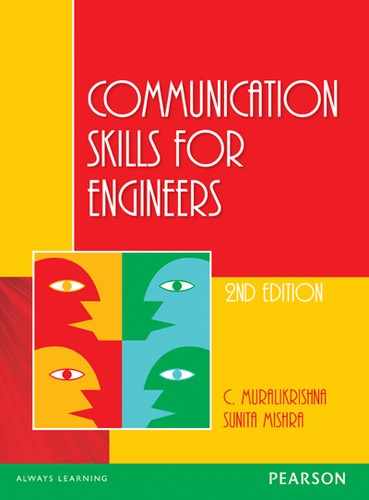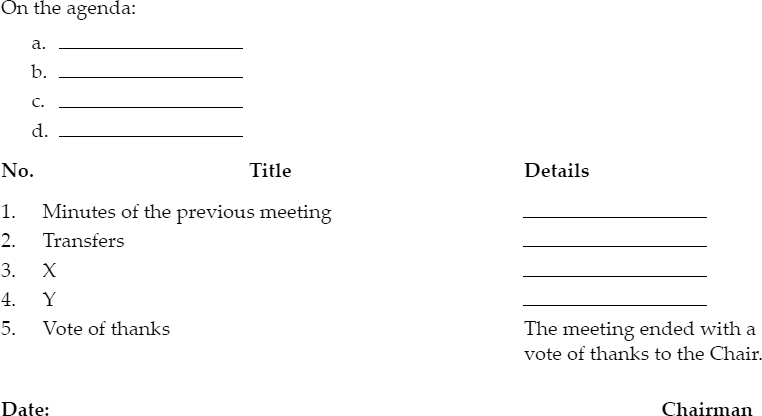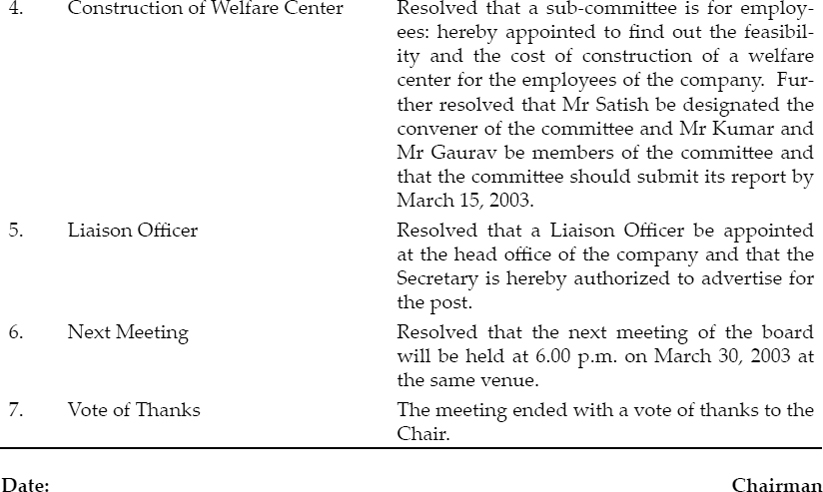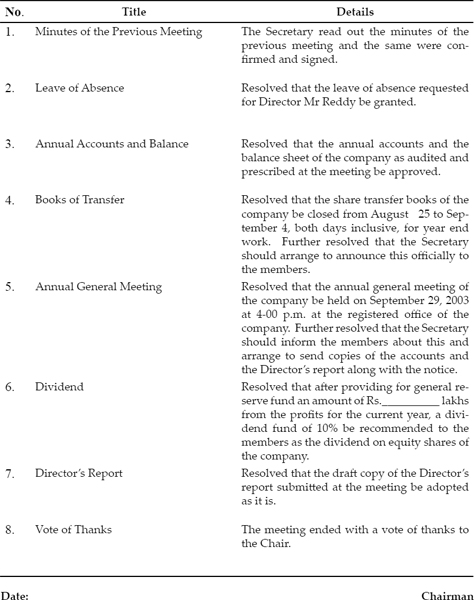CHAPTER 10
Telephone Skills, Meetings and Minutes
Chapter Objectives
This chapter discusses the important aspects relating to telephoning, conducting of meetings and minutes writing. It focuses on the do's and the dont's of these processes. The purpose of the chatper is to familiarise students with these concepts and enable them to use it when necessary.
TELEPHONIC COMMUNICATION
Telephones are a common means of oral communication. It is not always possible to have face-to-face contact with the personnel within and outside one's organization. But it is easy to contact one another on the telephone. Planning telephone calls is a simple, yet important activity, which does not take much time. Planning calls saves speaking time and money. We can always prepare an item list and have the relevant papers at hand, before making a call.
Some points with regard to telephoning
1. Positive (Do's)
- Calls are to be answered promptly.
- Pen and message pad have to be kept at hand.
- Statements and replies are to be given with the appropriate information. E.g. Extension 227, Ravindran speaking.
- Responses are to be spoken into the mouthpiece pleasantly and distinctly.
- Voices of people we know are to be recognized and their names used or the caller's name has to be obtained politely.
- People who may have to be put on hold on the phone while waiting for information have to be assured periodically that their concern would be addressed at the earliest.
- Callers have to be given the chance to ring back instead of being placed on hold for a prolonged period..
- Messages have to be taken and written out correctly so that the recipient will be able to read them easily. The messages have to be kept at a place where they will be seen.
- When callers become annoyed or impatient, the receiver should exercise self-control.
- Knowing enough about one's organization helps the employee to re-route calls that come to him by error.
- Instructions are to be left, when an employee is expecting a call during his absence.
- During a call, distractions are to be avoided.
- Cultivate a lively telephone voice. Find out how you sound from your friends or relatives.
- A lot of care has to be taken while speaking to foreigners.
- Be very clear and distinct while giving names and numbers.
- If the person the caller wants is not available, offer a return call.
- Before calling anybody, ask yourself if it is the right time to call and why you want to call.
- Before making a call, jot down the points to be made and keep all the necessary documents at hand.
- Have a clear idea of the message for the person you are calling.
- When someone answers your call, greet him or her and identify yourself.
- Apologize, in case you get through to a wrong number.
- When you get through to the right person, check if it's the right time to talk to him or her.
- Re-dial if the line gets disconnected. When the call is complete, thank the person you have spoken to.
- After making a call, jot down the key points of the conversation for future use and also to avoid forgetting them.
2. Negative (Don'ts)
- The instrument should not be misused.
- Slang expressions should be avoided.
- A conversation should not be carried on with someone else in the room while attending a call.
- A person who is wanted on the telephone should not be called across the room unless, the mouthpiece is covered.
- Do not ramble during a call. Be considerate to the other person, as he or she may be in a hurry.
- Before answering a call, don't let the phone ring more than two or three times.
- Do not allow the phone to interrupt a meeting or anything equally important.
On the phone: A few patterns
Ram: Dials/connects/ (Phone rings) Operator: Hello, NTPC. Ram: Hello / Good Morning / Good Afternoon / I am Ram here. May I speak to Zaheer? Could you put me on to Zaheer? Could I speak to Zaheer? Operator: Yes sir, please be on the line. Ram: Hello, Ram here. May I speak to John, please? John: Speaking. Ram: Good Morning, Mr. John. Ram: Hello, This is Ram speaking. Could I speak to John please? Operator: Just a moment please. I'll put you through. John: Hello, John here. Kumar: Hello! Could I speak to Ram please? Operator: Sorry, there is no Ram here. May be it's a wrong number. Kumar: Oh, I'm sorry. Operator: It's all right.
MEETINGS
Some people must learn that a meeting of minds and a bumping of heads are quite different things.
—Dell Pencil Puzzle and Word Games
A meeting may be defined as a formal gathering of a group of people at a pre-arranged time and place. Though generally formal in nature, a casual and informal meeting with no prior notice is also possible. Meetings are generally held for the following purposes:
- Information gathering
- Information giving
- Persuading
- Problem solving
- Decision taking
- Settling disputes
- Formulating policies
Guidelines for Effective Meetings
- Circular or information has to be sent to all participants in advance about the time, place and probable length of the meeting.
- The agenda of the meeting should also be circulated. The topics to be discussed may be placed in order and the last item should be listed as AOB (any other business with the permission of the chair).
- As far as possible, the purpose of the meeting should be achieved through negotiation, consensus or majority vote. If the participants are unable to agree, it must be recorded.
- Notes of the meeting should be made for preparing the minutes.
Conducting a Meeting
If the responsibility of conducting a meeting falls on you, you will need all the skills at your command to maintain control and create the right atmosphere for discussion. You should start the meeting with a summary of the objectives of the meeting and define the terms and scope of discussion. This will help you to keep the discussion relevant and on track. Very often, participants tend to cross talk or indulge in private discussion in groups. Differences of opinion may emerge and tempers do get lost. It is necessary for you to be calm and restrain the over-enthusiastic members. This can be done by ensuring that everyone gets a chance to speak, particularly the silent ones. The meeting should be concluded with a final summary that reiterates the conclusions of the meeting and provides information about the date of next meeting. Make sure that someone takes down notes to prepare the minutes. Firmness but openness with sensitivity to individual speakers and listeners are the hallmarks of an effective chairperson.
Participating in a Meeting
Be sure of your facts and information. Be clear in your mind about what you want to say and say it with clarity and confidence. It is true that due to power equations, it may not be possible to be forthright but you may express yourself by giving your reasons for your point of view.
If you have to interrupt other participants, do so politely. The same applies when you are contradicting or criticizing others.
The Language of Meetings
The following are some of the phrases generally used during meetings:
Chairing a meeting
- Good morning/afternoon/evening
- I welcome you all to this meeting
- The copy of the agenda is in your hands.
- We shall begin with…
- _____, would you like to begin with…
- Your attention is drawn to…
- I particularly wish to draw your attention to…
- Are we all agreed that…?
- We seem to be losing sight of the main point…
- We seem to be getting sidetracked
- We can talk about it later when we have got all the information.
- I should like you to vote in this issue.
- If no one has any objection, I propose that we leave this matter in abeyance till we can discuss this further.
- I'm afraid that we'll have to end here.
- To summarize, we decided that…
- Thank you all for coming.
- I would like to thank you all for your cooperation.
- That concludes our business for today and I declare the meeting closed.
Taking part in a meeting
- Excuse me, Mr Chairman, may I say something.
- May I comment on what…has just been said?
- Could I say something here, please?
- Could I make a point about…?
- May I add to what he has just said?
- It sounds like a good idea but....
- That doesn't sound to me like a very good idea…
- Let's not forget that…
- Are you sure that…
- I should like to remind the gathering that …
- Perhaps I haven't made myself clear…
- Under no circumstance can…
- I agree to…
While refusing ice cream after lunch, a professor told the students that he had a health problem. After a pause, he said it all, “Some people have dental problems, and some others have transcendental problems.”
MINUTES WRITING
A report covering the proceedings of a meeting of a business organization is known as ‘minutes of the meeting’. The minutes of any meeting – whether it is a company's board meeting or a managing committee/executive committee meeting of an association – are written by the secretary of the organization. As the minutes represent a legal record of the proceedings of meeting, the decisions taken are recorded in the form of resolutions. Personnel references are avoided as far as possible. Passive voice sentences are generally preferred.
E.g. Instead of saying: “Mr Bhujang's proposal that a new storeroom should be built for the corporation was passed”, in the minute book it is recorded as “Resolved that a new storeroom be built for the benefit of the corporation”.
If the minutes are minutes of narration, personal references are included but not when the matter is of a defamatory nature. In the minutes of decisions, no names are mentioned.
Minutes have to be correct. Normally resolutions are numbered in the serial order and the serial numbers are carried forward from one routine board meeting to another. Formal changes of the office-bearers have also to be recorded. Misrepresentation of facts regarding the proceedings of a meeting is an offence and hence the normal custom is to read out the minutes of a meeting at the beginning of the next meeting and get them approved by the members before the chairman signs them.
Pattern of Minutes

The following are the important features of a well-written minutes:
- The minutes are generally written on the letterhead of the company.
- At the beginning of the minutes, there are details such as the day and date on which and the time at which the meeting was held, the venue of the meting and the kind of meeting it was supposed to be.
- This is followed by a list of those who were present at the meting.
- The first resolution is normally the confirmation of the minutes of the previous meeting and the last resolution is normally the formal vote of thanks to the Chairman.
- If any member/Director is absent and has written for permission, this resolution comes second. But if a condolence resolution is to be passed, it comes after the approval of the minutes of the previous meeting.
- When an appointment is recorded (individual/group/sub-committee) the sentence says that the person or the committee “is hereby appointed”. Similar wording is used when someone is authorized to do something in the name of the company.
- At the end of the minutes, there should be provision for the date and the Chairman's signature. This data is the date on which the minutes are confirmed and signed.
ACTIVITY
- Draft the minutes of the monthly executive committee meeting of your cooperative society at which, among other things, the following items were on the agenda:
- To consider the proposal for increase in the loan amount.
- To consider the need for acquiring a permanent structure for the society.
Minutes of Routine Board Meetings of Companies
Minutes of the routine meetings of Boards of Directors of Companies are guided by the agenda that is given. Some routine activities besides the agenda can also be recorded in the minutes, if these have been undertaken during the meeting. Prominent among these are considerations of applications for transfer of share certificates etc. The major items on the agenda are normally given in advance. If the agenda contains proposals that cannot be subject to spot-decisions, committees are appointed for further investigation or study of the problem. When committees are appointed, the convenor and the members are mentioned by names, and the date by which they have to report to the Board is specified.
Sample 1: Minutes of a Routine Board Meeting
Minutes of the monthly board meeting of Bibliophile Publications Ltd. at which, among other things, the following items were on the agenda:
- To consider the proposal for extension of the administrative office building of the company at Narayanguda.
- To consider the request for building a welfare center for the employees of the company.
- To consider the suggestion of appointing a Liaison Officer for the company.
BIBLIOPHILE PUBLICATIONS LTD.
Minutes of the Routine Board Meeting of the Directors of Bibliophile Publications Ltd, held on February 17, 2003, at 4-00 p.m. at the registered office of the company in Hyderabad.
| Present : | Mr Madhusudan |
| Mr Janakiram Rao | |
| Mr Adinarayan Rao | |
| Mr Muniraj | |
| In Attendance: | Mr C. Thrinath (Secretary) |
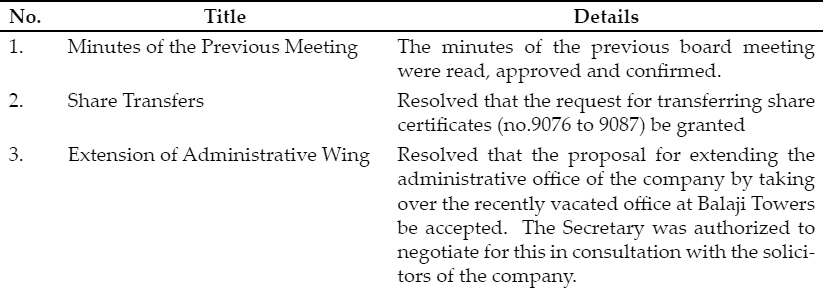
Sample 2: Minutes of the Meeting of Board of Directors (meeting held before the Annual General Meeting).
The board of directors holds a routine meeting before the annual general meeting to prepare for the annual general meeting. This meeting is known as the meeting of the board prior to the annual general meeting. Among the most important items of business transacted at this meeting, will be those recommending the dividend deciding on the date of the annual general meeting, deciding on the dates on which the register of the company will be closed, etc.
(Minutes of the Board Meeting (before the Annual General Meeting)
PRIME ATTIRES LTD
Minutes of the meeting of the Board of Directors of Prime Attires Ltd. held on August 27, 2003, at 5-00 p.m. at the registered office of the company at New Delhi.
Present:
Mr Kishore
Mr Jaisimha
Mr Vijayachander
Mr Osman Ali
Mr Aditya, Secretary.
SUMMARY
- Telephones are a common means of oral communication
- Planning telephone calls is a simple, yet important activity, which does not take much time.
- Planning calls saves speaking time and money.
- We can always prepare an item list and have the relevant papers at hand, before making a call.
- A meeting may be defined as a formal gathering of a group of people at a pre-arranged time and place.
- Though generally formal in nature, a casual and informal meeting with no prior notice is also possible.
- Meetings are generally held for various official and semi-official purposes.
- Certain guidelines for conducting effective meetings including preparing an agenda, should be prepared.
- In a meeting, an effective chairperson has to be firm but open and sensitive to individual speakers and listeners.
- A report covering the proceedings of a meeting of a business organization is known as ‘minutes of the meeting’
- Minutes writing is an important aspect of meetings in modern business
REVIEW QUESTIONS
- What are the essentials of an effective telephone call?
- What are the benefits of a telephone?
- What are some of the do's and don'ts of telephone conversation?
- What is a meeting and an agenda?
- What are the purposes of conducting meetings?
- What is meant by ‘minutes of a meeting’?
